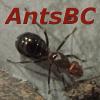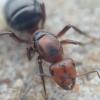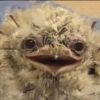i was on a nice day walking on my back yard (near a desert that's near a river) and thought
that rock looks lift-able, and found a pheidole colony (mind thatt at the moment i just had 1 catch cup) i was observing them until i find the queen,
i lifted the queen with my hand and saw something odd, there was another ant that wasnt pheidole, it was a solenopsis phoretica queen, the queen 1 (solenopsis phoretica) realized that she was in danger and started franticly looking for the pheidole
queen to ride her as seen in this picture (credit of alexander wild)

so i placed the queens on a rock filled with workers and brood and took them home to place them in a test tube
i passed them into a test tube and after doing some research the only thing i found was, very few info is known about their activities after the host queen has found a nesting place
so i did oservations like
*the queen will not kill the host, there fore the host will develop a colony wich will feed her, i find pheidole is easy to trick in that way because they are used to having more than 1 queen.
*the queen 1 will not produce any type of workers, yet
* the queen 1 will stop riding piggyback after the queen has the host workers to defend her.



















